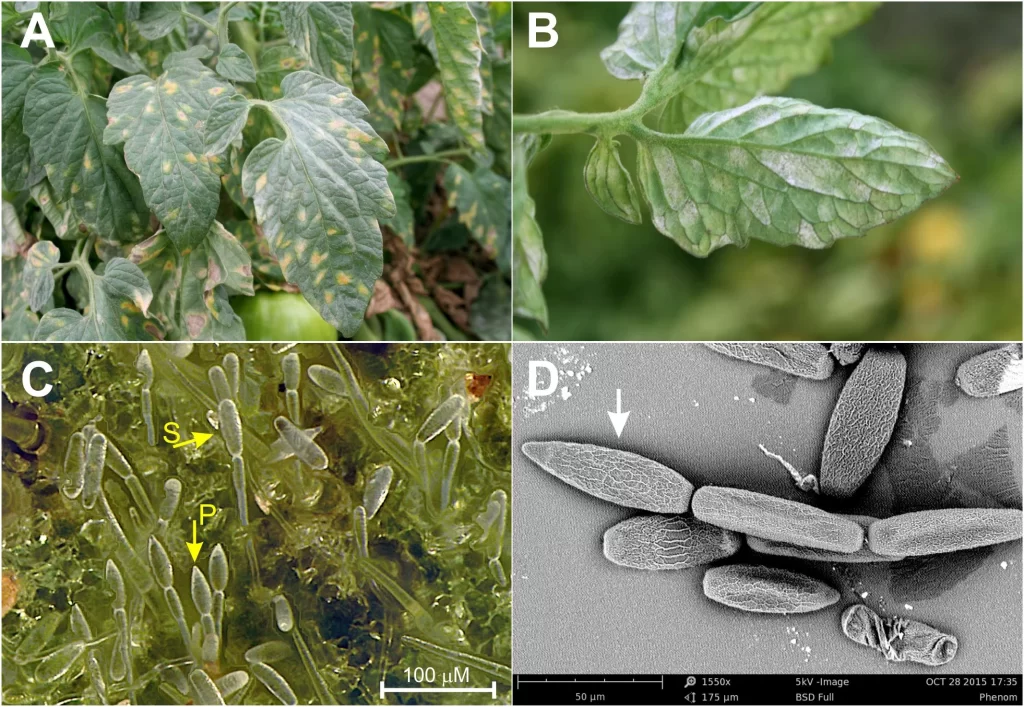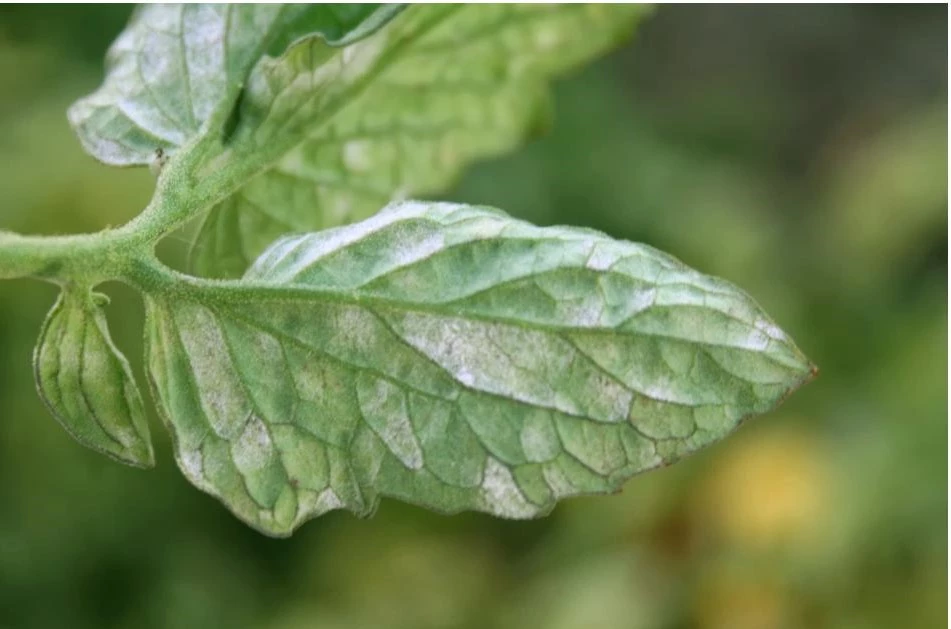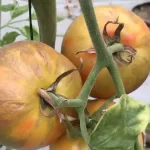
Written by: Becky Anderson
Published by: David Santos
Powdery Mildew (Leveillula taurica)
See our Resource page to see what we aim to cover in each post.
What is Leveillula taurica?
Leveillula taurica (also known as Oidiopsis taurica [1] in its asexual state) is a fungus which causes “powdery mildew” on plants among the Solanaceae, Alliaceae and Cucurbitaceae families [2]. However, some plants are naturally resistant to L. taurica, such as some species from the genus Capsicum, Table 1. Powdery mildew caused by L. taurica has been found worldwide and is a source of significant economic loss, resulting in a loss by up to 40% in tomato plants if left uncontrolled [2].
species: level of taxonomic identification for an organism, one level below genus
genus: level of taxonomic identification for an organism, one level below family
taxonomy: The branch of science concerned with classifying organisms. Taxonomic ranking is used to classify and identify organisms (Domain, Kingdom, Phylum, Class, Order, Family, Genus, Species)
Table 1. Examples of known plants which are susceptible or resistant to Leveillula taurica
| Susceptibility | Family | Genus and species | Common name |
| Susceptible | Alliaceae | Allium porrum | Leeks |
| Alliumsativum | Garlic | ||
| Allium schoenoprasum | Chives | ||
| Allium cepa | Common onions | ||
| Cucurbitaceae | Cucurbita pepo | Summer Squash | |
| Cucumis sativus | Cucumbers | ||
| Cucumis melo | Melons | ||
| Solanaceae | Solanum lycopersicum | Tomato | |
| Solanum tuberosum | Potato | ||
| Solanum melongena | Eggplant | ||
| Capsicum spp. | Pepper (various) | ||
| Resistant | Solanaceae | Capsicum annuum | Red pepper (paprika) |
| Capsicum baccatum | Chili pepper | ||
| Capsicum frutescens | Tabasco pepper | ||
| Capsicum chinense | Habanero pepper | ||
| Capsicum pubescens | Rocoto pepper |
Resistant plants are summarized in papers from Parisi et al., 2020 [1], Anand et al., 1987 [3], De Souza et al., 2003 [4] and Lee et al., 2001 [5].
Infection and Symptoms:
Powdery mildew caused by L. taurica presents itself as white, irregular patches on the abaxial surface of leaves and yellow, chlorotic patches on the adaxial side of leaves, Figure 1A and 1B [2]. These patches are necrotic and result in a destruction of leaves which fall off the plant. Lack of leaves can result in sunburned fruit, defoliation, reduced photosynthetic ability and ultimately, a reduction in fruit yield [6].
abaxial: underside of leaves, facing away from the stem
chlorotic: yellowing of a leaf due to lack of chlorophyll
adaxial: upper surface of leaves, facing toward the stem
necrotic: producing death in a localized area of a living tissue
defoliation: the premature deprivation, or loss, of leaves
photosynthetic: relating to the process of photosynthesis

Infection with L. taurica occurs when spores land on the leaves, enter through the stoma, germinate their mycelia and grow in the mesophyll for 3-4 weeks [2, 7]. The mycelium then grows out through the stomata and resides on the surface of the leaf where you will see the characteristic white and yellow spots [2]. Therefore, early monitoring and surveillance is necessary since it takes around 21 days for symptoms to be visible after infection [7].
spores: microscopic particle which allows for fungus to reproduce
stoma (plural: stomata): a pore found in the epidermis of a plant which allows for the exchange of gas
germinate: to come into existence and develop
mycelium (plural: mycelia): root like structure of a fungus which consists of branching
mesophyll: the inner tissue of a leaf containing chloroplasts (contains chlorophyll and is where photosynthesis takes place)
Growth Conditions and Hydroponic systems:
L. taurica thrives in warmer climates, whether it is dry (arid or semi-arid) or humid, making greenhouses and indoor facilities such as hydroponic farms, an ideal environment. However, Ideal growth temperatures include 19-33˚C [7]. L. taurica is highly transmissible and their spores can spread quickly within hydroponic systems to nearby plants through direct contact or airborne transmission.
Various methods are used to treat L. taurica infections in plants, with the most effective method being chemical treatment [6]. However, extensive use of fungicides and pesticides in agriculture has led to pathogens developing a resistance to these chemicals [2]. Due to the acquired resistance, many chemical treatments no longer work or require high concentrations that can cause health risks to humans, animals or the environment. These chemical treatments include but are not limited to the fungicides demethylation inhibitors (DMIs) and quinone outside inhibitors (QoIs) aka strobilurins [2].
fungicide: a chemical that targets and destroys fungus
pesticide: a chemical that destroys pests and/or other organisms which are harmful to plants and/or animals
acquired resistance: resistance which is obtained through mutation or acquisition of genes, in an otherwise susceptible organism
Alternative treatment methods which are safer for humans, animals and the environment are being investigated. These include the use of bacterial or fungal inoculants that produce by-products which hinder the growth of pathogens such as L. taurica and the use of resistant cultivars, or species of plants, which can slow or completely stop the spread of powdery mildew (Table 1). Inoculants, which have been investigated and shown promising effects at controlling powdery mildew compared to traditional fungicides, include Trichoderma viride, Tricoderma harizianum [8] Ampelomyces quisqualis and Pseudomonas fluorescens [9] However, further research is still needed before the use of these inoculants become standard practice.
bacterial or fungal inoculants: a bacteria, or fungus, which is used as an agricultural amendment for a beneficial purpose
by-products: an incidental or secondary product made by an organism, usually as a waste product
pathogen: a microorganism (e.g. bacteria, fungus or virus) that can cause disease
Steps for controlling L. taurica in greenhouses*:
- Contact your seed supplier for resistant cultivar, such as the resistant pepper varieties in Table 1.
- Restrict visitor access and personnel within the greenhouse
- Follow strict hygiene and good practices
- Thoroughly disinfect and dispose of crops (e.g. through burning) during year end clean up
- Control weeds in surrounding areas
- Keep ornamental and tropical plants outside of greenhouse
- Modify the internal environment to reduce humidity and increase air flow
*These steps were adapted from The BC Ministry of Agricultural, Food and FIsheries [7] see the link below for further details.
Disclaimer:
The information we present in Pathogen Profile is based on collating published peer-reviewed scientific literature and sources we think are reliable. This is by no means an exhaustive review of pathogens. Pathogen Profile gives a small glimpse of what is known about pathogens and we encourage growers to do more research on their own based on the pathogens in relation to their own crops and hydroponic systems. We are not plant pathologists thus the information presented in Pathogen Profile should not be used as professional advice to treat pathogens or to operate your hydroponic system.
Works Cited
- Parisi, Mario, Daniela Alioto, and Pasquale Tripodi. 2020. “Overview of Biotic Stresses in Pepper (Capsicum spp.): Sources of Genetic Resistance, Molecular Breeding and Genomics” International Journal of Molecular Sciences 21, no. 7: 2587. https://doi.org/10.3390/ijms21072587
- Mosquera S, Chen L-H, Aegerter B, Miyao E, Salvucci A, Chang T-C, Epstein L and Stergiopoulos I (2019) Cloning of the Cytochrome b Gene From the Tomato Powdery Mildew Fungus Leveillula taurica Reveals High Levels of Allelic Variation and Heteroplasmy for the G143A Mutation. Front. Microbiol. 10:663. https://doi.org/10.3389/fmicb.2019.00663
- Anand, N.; Deshpande, A.A.; Sridhar, T.S. Resistance to powdery mildew in an accession of Capsicum frutescens and its inheritance pattern. Capsicum Eggplant Newsl 1987, 6, 77–78. https://doi.org/10.5897/AJAR2018.13340
- De Souza, V.L.; Café-Filho, A.C. Resistance to Leveillula taurica in the genus Capsicum. Plant Pathol. 2003, 52, 613–619. [CrossRef] http://dx.doi.org/10.1046/j.1365-3059.2003.00920.x
- Lee, O.H.; Hwang, H.S.; Kim, J.Y.; Han, J.H.; Yoo, Y.S.; Kim, B.S. A search for sources of resistance to powdery mildew (Leveillula taurica (Lev.) Arn.) in pepper (Capsicum spp.). Korean J. Hort. Sci. Tech. 2001, 19, 7e11. (https://www.koreascience.or.kr/article/JAKO200128066987716.page)
- César Guigón López, Laila Nayzzel Muñoz Castellanos, Nallely Alejandra Flores Ortiz, and Judith Adriana González González. “Control of powdery mildew (Leveillula taurica) using Trichoderma asperellum and Metarhizium anisopliae in different pepper types” BioControl 64, no. 1 (2019): 77-89. https://doi.org/10.1007/s10526-018-09916-y
- The BC Ministry of Agricultural, Food and FIsheries https://www2.gov.bc.ca/assets/gov/farming-natural-resources-and-industry/agriculture-and-seafood/animal-and-crops/plant-health/phu-powderymildew-greenhousepeppersss.pdf
- Kumar and Reddy 2007 http://www.globalsciencebooks.info/Online/GSBOnline/images/0712/FVCSB_1[2]/FVCSB_1[2]126-130o.pdf
- Kumar 2008 http://www.globalsciencebooks.info/Online/GSBOnline/images/0812/AAJPSB_2(1&2)/AAJPSB_2[2]107-112o.pdf
Looking for more useful info? Go back to the Blog Page or checkout the Resources Page.




